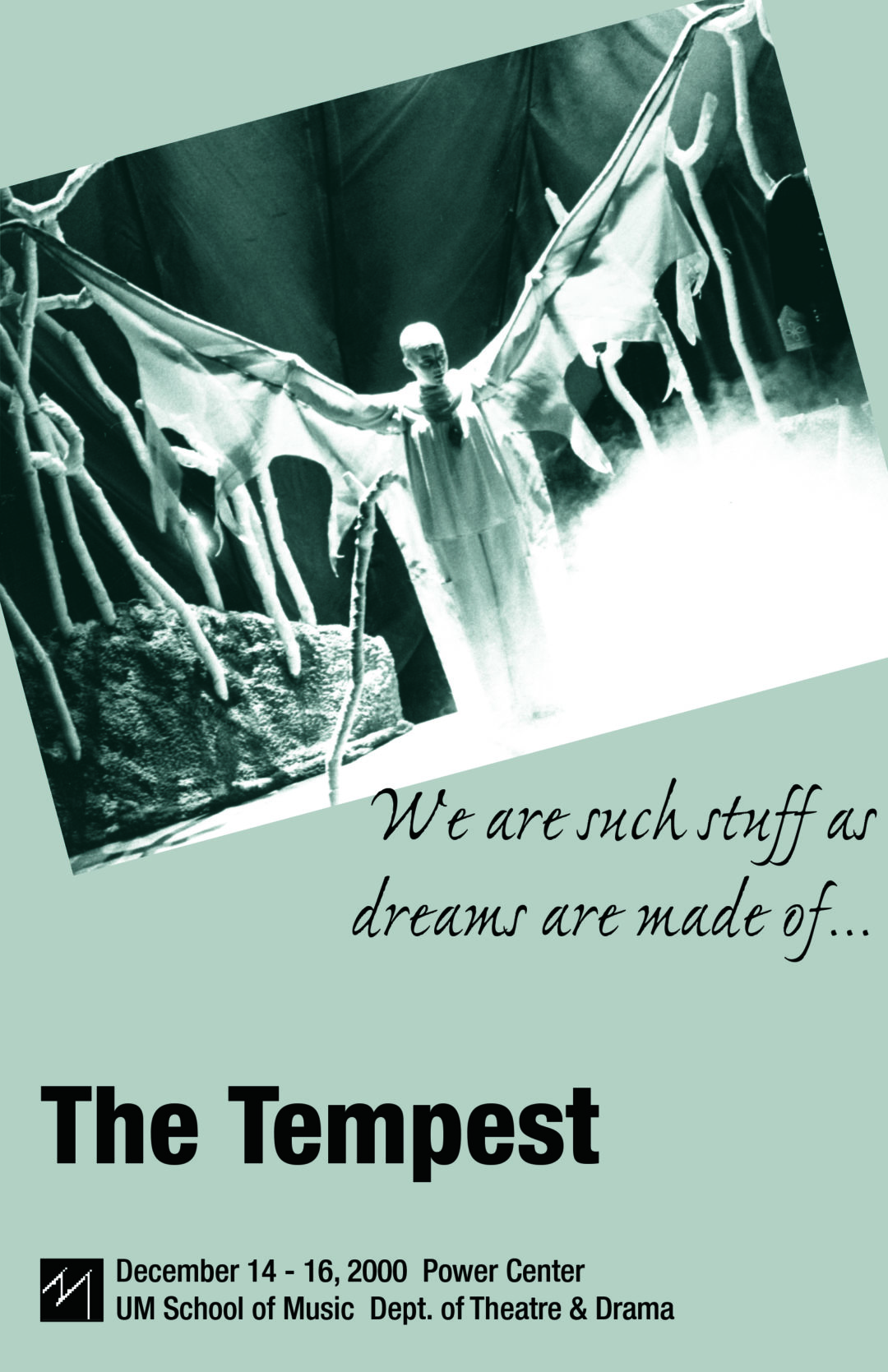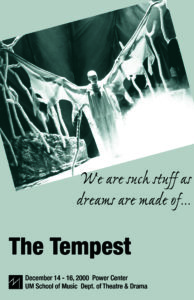The Tempest – Revival
By William Shakespeare
Department of Theatre & Drama
December 14-16, 2000 • Power Center
The University of Michigan Department of Theatre & Drama will remount its acclaimed production of The Tempest for three performances. An all-star cast of more than a dozen top faculty actors, dancers and singers, as well as student performers, bring this tale of magicians, fairies, goddesses and kings to life.
The Tempest is a play that has delighted audiences for almost 400 years and is regarded by almost all scholars to be Shakespeare’s last complete work. The play defies easy categorization. Although it is clearly a comedy in the classical definition of the genre, such a description sits a little uneasily with modern audiences more accustomed to associating comedies with belly laughs, sight gags, and television sit-coms. While there is ample room for such an interpretation, the work, at least since the 19th century, has generally been played as a “romance.” There is an element of the “tragic” to be found within the text as well. Shakespeare’s late masterpiece is very concerned with issues such as the nature of authority, the clashing demands of revenge and forgiveness, of justice and mercy. The story also dwells on the affairs of the heart. In The Tempest, Miranda, Prospero’s beautiful daughter, has never set her eyes upon any human being other than her father since her infancy. When a bevy of frightened men, both corrupt and honorable, are shipwrecked upon the shores of Prospero’s mystical island following a terrible “tempest” at sea, Miranda is immediately struck with the beauty of a noble youth, Ferdinand, the son of the King of Naples. The story follows this affair, but not without first taking the audience on a truly magical journey.
Artistic Staff
Director: Philip Kerr
Consulting Director: Mark Lamos
Assistant Director: Sarah-Jane Gwillim
Scenic and Lighting Designer: Rob Murphy
Costume Designer: Nephelie Andonyadis
Wig and Make-up Designer: Guy Beck
Original Score and Sound Designer: Frank Pahl
Choreographer: Peter Sparling
Dramaturg: Cara Gabriel
Stage Manager: Nancy Uffner
Cast
Alonso, King of Naples: Leigh Woods
Sebastian, his brother: Michael Spatafora
Ferdinand, Alonso’s son: Maclain Looper
Gonzalo, a counsellor: Beverley J. Pooley
Adrian, a lord: George Shirley
Trinculo, a jester: Malcolm Tulip
Stephano, a butler: John Neville-Andrews
Prospero, the right Duke of Milan: Philip Kerr
Antonio, his brother, the usurping Duke: Anthony von Halle
Miranda, Prospero’s daughter: Julia Siple
Ariel, a spirit: Maggie Smythe
Caliban, an islander: Erik Fredricksen
Juno, a goddess presented by a spirit: Deanna Relyea
Iris, a goddess presented by a spirit: Anna Gleichauf
Ceres, a goddess presented by a spirit: Christina Reynolds
Prospero Spirit: Bill De Young
Miranda Spirit: Lisa Catrett-Belrose
Ferdinand Spirit: Tim Smola
Boatswain: Quinn Strassel
Master of a Ship: Martin Walsh
Sailors: Steve Best, Dan Hall, Zachary Leland, Michael Mischler, Eddie Murray, Aaron Michael Sherry
Sponsors
Funding for The Tempest provided by grants from the Office of the President, Rackham Graduate School and the Office of the Vice-President for Research.
Resources
[accordion title=”A Greeting from the Chair”]
Like as the waves make towards the pebbled shore,
So do our minutes hasten to their end;
Each changing place with that which goes before,
In sequent toil all forwards do contend.
The constancy of ending and beginning, the inevitability of cessation and reproduction, is a leitmotif often appearing in Shakespeare’s plays through the metaphor of the sea. Arrival and departures is, appropriately, a theme in the re-mounting of The Tempest.
Last year, through a celebration of the achievements of Dean Boylan’s leadership and a dedication to him on his departure, we first presented this production. And, in the seamless scene shifting, “…each changing place with that which goes before,” we welcome a new leader in a new season, Dean Karen Wolff.
However, the purpose, the work, and hope of this re-mounting is not motivated by deserved encomiums directed at exits and entrances only. Always appropriate professional modesty cannot overwhelm the equally responsible observations expressed in these lines of the poet Thomas Gray:
Full many a gem of purest ray serene,
The dark unfathomed caves of ocean bear:
Full many a flower is born to blush unseen,
And waste its sweetness on the desert air.
These lines, too, bring us to a locus appropriate to The Tempest, and a sentiment essential to the re-mounting this year. The potential of a collaborative consonancy in the School of Music was our hope last year, it is our belief this year. The “act of theatre” has always been an enthusiastic investigation of disciplines and, in many cultures, does not distinguish in definition between the respected allies of music and dance. Additionally, we must always be mindful that in the education of an artist, intimacy with the craft instructs one that when training people of any age to embark on their journeys, one needs to teach not only the skill but the art as well. Thus, unlike Prospero at work alone in his cell, faculty, staff, and students – in an age-old public classroom – study our lessons together, seeking under special scrutiny your consideration and approval.
During this holiday season, filled with its own magic, we revisit a special shore still seeking to divine the “…stuff as dreams are made on…” The Department of Theatre and Drama is delighted to welcome you to our offering of The Tempest, combining the School of Music’s many riches to make this evening possible.
– Erik Fredricksen, Chair of Theatre and Drama
[/accordion][accordion title=”Director’s Notes”]
If life is a voyage, then the Theater is one of the ships that we board occasionally in order to reach our destination. The ship can take us to nothingness or it can take us to a new reality.
The root of the word “tempest” is tempus – time. So perhaps it is fitting that this production of one of Shakespeare’s last plays takes place on the eve of the millennium. The play itself deals with time remembered as well as a sense of ending, transformation into a new time. Evocations of sleep and lapsed responsibility that must be dealt with in the future are woven into the play’s dreamlike fabric, and time seems to move in fits and starts on Prospero’s magic island.
It’s a four-hundred-year-old play. But we are presenting it today; therefore, it wears our clothing. Shakespeare’s actors performed in contemporary clothing; we are continuing that tradition.
Its themes are transformation and the ambiguous powers of Art. Written as the old world created a New World in, among other places, the eastern shore of America, The Tempest reflects the moral imagination of America, the ruthlessness of history, and the loss of belief in Paradise and Art.
The Tempest is a series of illusions that dissolve into reality – or other illusions, depending on the way you look at it. It’s about the limits of Art, the madness of History, and the possibility of human redemption through Art and Illusion.
The Tempest says movement is natural, stasis is unnatural. It comes from the sea of Life and dissolves into the air of the Theater. It begins in chaos and ends in release. It acknowledges technology as the natural consequence of history and as the enemy of Art, Mystery, Religion.
The Tempest says Freedom and Liberty can be achieved only through restraint. It’s a play about people who are enslaved – to their masters, to their desires, to their work, to their obsessions, to their time, to their fellowmen, and ultimately, to the audience watching them – as actors on a stage.
The Tempest is about itself and the audience that watches it, “exchanges eyes” with it – the audience that through its power is brought to the door of transformation. The play is full of sleep images – Shakespeare believes that to give yourself over to Art and Illusion, you must suffer the enslavement of sleep, the dream. In dreams begin responsibilities. From responsibility comes humanity and love.
The play is cyclical, beginning and ending with a sea voyage. It does not explain; rather, it shows. And it presents shows, visions, tricks, masques, illusions. It is peopled by monsters, angels, clowns, magicians, virgins, politicians. In short, by people like us.
Shakespeare’s profound skepticism is also realized. By forcing politicians and maguses, monsters, muses, and clowns to inhabit the same frame (or island, if you will) in The Tempest, the playwright insists that we accept a universe larger in scope than the one in our heads. This is the source of his humanism.
This unusual production involves an extraordinary group of gifted people: faculty members and students in theater and music at the University of Michigan, all artists. In this confluence it echoes what I call The Shakespearean Intention: the amalgamation, the commingling of various and seemingly disparate types of people – old and young, mature and youthful, master and journeyman, etc., into a great harmonious dance. The harmony may be filled with contradictory dissonances, but a rare polyphony is the outcome. Think of A Midsummer Night’s Dream with its delicious jumble of rude mechanicals, young lovers, Ovidian royals, and warring fairies. All of Shakespeare’s plays insist on a similar community of opposites to achieve their profound effects of universality.
The Tempest was the last complete play Shakespeare wrote. Its poetry stretches the limits of the English language. It is a poem, a contemplation, a sea-changed vessel that demands our abilities as sailors, dreamers, slaves. By giving up our present reality and allowing our childlike wonder to give the powers of play full sway, we take a step towards redemption. If we can suspend our disbelief, even for a moment before the illusion is ripped from our eyes, we are capable of transformation and metamorphosis. If we are capable of transformation, we’re capable of redemption. The Tempest is a play for people who can listen to the music of language, a play for those who trust the power of words to mean what they symbolize. It is about what happens to you during the two hours or so that you spend experiencing it. The Tempest acknowledges the media for what it is: “an insubstantial pageant faded;” it prophesies that the globe will dissolve, too. The end of the voyage is dust (the earth, the grave, the shore) or Paradise (the air, the grave, the shore).
The end of the play is the final request for Liberty: an actor on a stage asks the audience to release him. In doing so, you acknowledge the fact that you’ve just spent some time in a theater, and you acknowledge, too, that you believe what he’s asking you is true.
— Mark Lamos
[/accordion]


